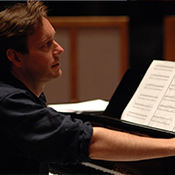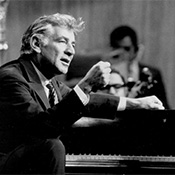
From Conductor to Arranger: Cristian Măcelaru brings Jake Heggie’s Moby-Dick Suite to the MSO
DAVID LEWELLEN
PUBLISHED
Tagged Under: 2017.18 Season, Classics, Conductor, Guest Artist
The Milwaukee Symphony already knows Cristian Măcelaru as a conductor, but this weekend, audiences will also meet him as an arranger.
Măcelaru, who will conduct the MSO’s first program of the new season, also arranged the Moby-Dick Suite, having extracted about 20 minutes of material from Jake Heggie’s opera based on the classic novel.
“Moby-Dick is the most symphonic of Jake’s operas,” Măcelaru said, and he got to know the piece intimately when he served as assistant conductor of the world premiere at the Dallas Opera in 2010. He kept urging Heggie to use it as the basis for an orchestral suite, “and he kept saying he was too busy, and finally I said, ‘Can I do it for you?’”
To put the music in symphonic form, Măcelaru re-orchestrated passages that originally included singing, and composed some transitions that were faithful to Heggie’s musical language. “I used to do a lot more composing when I had more time,” he said. “But I love it a lot. It’s my biggest hobby.”
The suite had its world premiere this past summer at the Cabrillo Festival of Contemporary Music in Santa Cruz, Calif., where Măcelaru just finished his first season as music director. Heggie sat in on the rehearsals and made suggestions that were used in the final product.
In programming the MSO concert, Măcelaru said he suggested several contemporary American pieces, “and my last one was Moby-Dick, because I hadn’t written it yet. But that was the one they chose.” Heggie is best known for operas and songs, and “everyone loves Jake’s music, but there are not many pieces that are purely orchestral,” Măcelaru said — which may account for the interest that other orchestras have shown in the piece. (This weekend’s performances will be the first following the premiere.)
The program, and the MSO’s season-long salute to Leonard Bernstein, begins with the short, exuberant overture to Candide. The third piece on the first half is Masquerade by the contemporary British composer Anna Clyne, which Măcelaru described as “fun in the same way that the Bernstein is.”
The second half, Beethoven’s Seventh Symphony, “is a completely different world,” Măcelaru said. “But it’s such a celebratory piece that it made sense for the idea of opening the season and welcoming people back to the concert hall.”
Before becoming a full-time conductor, Măcelaru began his career as a violinist, and he carries that perspective in pacing a rehearsal — and sometimes, in programming decisions. “Beethoven Seven is hard for strings, more than any other Beethoven symphony,” he said. “The first half is beautiful music, but not as demanding. So that made sense, to not be killing the orchestra in the first half and then putting Beethoven Seven on the stand in the second half and expecting them to do well.”
Măcelaru serves as conductor in residence for the Philadelphia Orchestra, and his regular guest appearances with other major U.S. orchestras have been well-received. Writing in the Los Angeles Times, Mark Swed praised “the huge sound he gets from the orchestra. … Măcelaru knows how to get attention like few of his peers. He’s now in an enviable position of being ready to figure out what to do with that great skill.”
However, Măcelaru has not yet become the music director of a year-round symphony. And of course, the MSO is currently looking to fill that position. But many things have to go right between an orchestra and a conductor.
Speaking in general terms, Măcelaru said, “Everything has to do with the orchestra, the organization, the chemistry in the community. It’s very important that it be a place that nurtures and supports this art form.”
Milwaukee audiences have heard recently that every guest conductor is a potential music director, and on the other side, Măcelaru said, “Every orchestra I conduct, I’m always open to having a deeper future connection with them. It’s a combination of all the things — who I am as a person, an artist, a potential citizen of the community. They all have to work together, and when they do, you know.”



